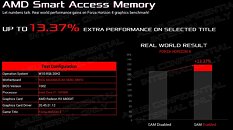Tuesday, December 1st 2020

ASUS Brings Resizable BAR Support to Intel Z490/H470/B460 Platforms
When AMD introduced its Smart Access Memory technology, everyone was wondering will other GPU and CPU providers, namely Intel and NVIDIA, develop a similar solution to complement their offerings. The SAM technology is just AMD's way of naming PCIe resizable Base Address Register (BAR) technology, which has been present in PCI specifications for years as an optional feature. Why it's emerging now you might wonder. Well, the currently used PCIe revision has reached enough bandwidth on the bus to complement the complex data movement that GPU requires and now supports the use of the wider VRAM frame buffer.
It appears that not only AMD has this technology in its portfolio. ASUS has updated its BIOS firmware for its ROG Maximus XII Apex motherboard based on the Intel Z490 chipset, with some pretty interesting features. According to Tom's Hardware, we have information that the next release of BIOS firmware update 1003 for the ROG Maximus XII Apex motherboard will bring support for resizable BAR, making it a first on an Intel platform. For now, the beta 1002 BIOS supports it, however, a stable version will roll out in BIOS 1003. With the motherboard using PCIe 3.0 standard, a lower-bandwidth revision compared to AMD's platform, it will be interesting to see how resizable BAR is performing once the first tests come.
Update 09:45 am UTC: Chris Wefers, ASUS PR Germany, has announced that resizable BAR will be coming to all ASUS motherboards with Intel Z490/H470/B460 chipset, with alleged 13.37% performance increase in Forza Horizon 4, per ASUSes testing. You can see the test configuration in the image below.
Sources:
Tom's Hardware (News Source and Picture), Chris Wefers (Twitter)
It appears that not only AMD has this technology in its portfolio. ASUS has updated its BIOS firmware for its ROG Maximus XII Apex motherboard based on the Intel Z490 chipset, with some pretty interesting features. According to Tom's Hardware, we have information that the next release of BIOS firmware update 1003 for the ROG Maximus XII Apex motherboard will bring support for resizable BAR, making it a first on an Intel platform. For now, the beta 1002 BIOS supports it, however, a stable version will roll out in BIOS 1003. With the motherboard using PCIe 3.0 standard, a lower-bandwidth revision compared to AMD's platform, it will be interesting to see how resizable BAR is performing once the first tests come.
Update 09:45 am UTC: Chris Wefers, ASUS PR Germany, has announced that resizable BAR will be coming to all ASUS motherboards with Intel Z490/H470/B460 chipset, with alleged 13.37% performance increase in Forza Horizon 4, per ASUSes testing. You can see the test configuration in the image below.


26 Comments on ASUS Brings Resizable BAR Support to Intel Z490/H470/B460 Platforms
would be nice if every CPU, chipset and GPU get this feature.
Could a "rogue" motherboard maker allow SAM to be used on ryzen 3000 series?
So technically yes, if the said MoBo was build after "BAR" was introduced into PCI-E specifications it could be allowed / integrated for this Mainboard by adjusting the BIOS (just like R5k cpu's can be used on MoBo's with the Right bios but can't if you didn't update it yet --- it's literally just a microcode injection making a function available or not Situation).
The only Question is, how well it would work and how much effort AMD put into their Version of it - if it's not optimized it could lead to lower Performance or, of Course, to similar gians as we've seen in the SAM Tests (with PCI-E 3 most likely a bit lower as there isn't as much Overhead bandwith as with PCI-E4 but in General, even PCI-E 3 is not totally/fully utilized at the Moment if you don't also use pci-e sata's/etc. )
SAM is the new feature that allow CPU to access the entirety of dGPU VRAM in one go, instead of a series of 256MB chunks.
The real issue here is having 3 different code bases managed by 3 very competitive companies, which could see features broken just to force upgrades or play hardball. AMD currently is the only one able to shelter themselves from a feature war if say, Nvidia was to lock some future-gen GPUs from SAM-linking with say, an old gen Ryzen or Intel, or Intel limiting the SAM feature to their high-end while ignoring the low end.
As for the last bit, in theory, a mobo maker could support SAM all the way back to Ryzen 1000, just as long as its on an AMD 400-series or 500-series chipset, as the feature is technically a PCIe 3.0+ specific feature. Maybe it could work on AMD 300-series chipsets, but I don't recall if all 300-series mobos had a PCIe 3.0 slot (IIRC, some budget ones only had 2.0), and even then, would only officially work with the PCIe 3.0 slot (usually the GPU slot). But considering that most support for AMD 300-series chipsets has since ended, in part due to AMD also ending it, it'll be up to dedicated coders to create custom BIOS that activate the feature on the 300-series.
On another note is the BAR setting in Nvidia bios intertwined with this BAR size like a frequency associated to it's speed limit I guess you could say while the BAR size itself is more like a wider highway.
I should see how hard it is to retrofit this ASUS work to other boards...
its been in the spec for years
Also take a gander at this and notice the CSM disabled part and 4G decoding the latter also being kind of fuzzy and interchangeable with MMIO 4GB.
www.techarp.com/computer/smart-access-memory-guide/
Lastly you've got this which describes the VRAM aperture as BAR1 also rather coincidental in turn. I'm pretty self convinced it's the same unless someone can definitively in a strong way prove otherwise at least for the time being. I think we could know more for certain perhaps when Nvidia enables support to be fair. If it's supported at the driver level by Nvidia on GPU's it should work if the MB supports it and I think Nvidia knows as much or wouldn't be coming out so quickly quite so guns blazing on the matter.
envytools.readthedocs.io/en/latest/hw/bus/bars.html
I also found this by Nvidia that talks about the BAR and the MMIO so yeah I'm fairly convinced.
docs.nvidia.com/cuda/gpudirect-rdma/index.html
It wasn't showing up in bios like I thought initially, but it's also a previous bios version so idk if the naming changed. There defiantly isn't a "accessible" option with the same naming structure in P7.30 bios it could be something a bios mod needs to enable I think you change something extended user I don't recall there is a way to temper with some stuff and enable/disable some bios options though by modding them with the AMI tool. There is something called TOLUD MMIO with a 2.5GB/3.5GB/Dynamic option in the version of the bios I have though that could possibly be the same option with slightly different naming in the older bios used. The CSM option was present though and already disabled by default and from what I read AsRock does that along with most other MB makers though Gigabyte seems to enable it by default apparently.